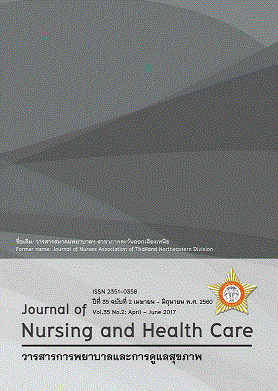การพัฒนารูปแบบการดูแลเพื่อป้องกันการติดเชื้อที่ตำแหน่งผ่าตัด สำหรับผู้ป่วยผ่าตัดทำทางเบี่ยงหลอดเลือดหัวใจโดยใช้หลักฐานเชิงประจักษ์ The Development of Care Model to Prevent Surgical Site Infection for Patients Undergoing Coronary Artery Bypass Graft Usin
คำสำคัญ:
รูปแบบการดูแล การติดเชื้อที่ตำแหน่งผ่าตัด การผ่าตัดทำทางเบี่ยงหลอดเลือดหัวใจ Care model, Surgical site infection, Coronary artery bypass graftบทคัดย่อ
บทคัดย่อ
การวิจัยเชิงปฏิบัติการนี้มีวัตถุประสงค์เพื่อ 1) พัฒนารูปแบบการดูแลผู้ป่วยผ่าตัดทำทางเบี่ยงหลอดเลือดหัวใจเพื่อป้องกันการติดเชื้อที่ตำแหน่งผ่าตัดโดยใช้หลักฐานเชิงประจักษ์ และ 2) ศึกษาผลการนำรูปแบบการดูแลไปใช้ต่ออัตราการติดเชื้อและจำนวนวันนอนโรงพยาบาลหลังการผ่าตัด การวิจัยแบ่งออกเป็น 2 ระยะ คือ ระยะที่ 1 การพัฒนารูปแบบการดูแลใช้กรอบแนวคิดการพัฒนารูปแบบการดูแลตามหลักฐานเชิงประจักษ์ของ Rosswurm & Larrabee แบ่งเป็น 4 ขั้นตอน ได้แก่ 1) การประเมินความต้องการ 2) การเชื่อมโยงปัญหาและผลลัพธ์ของการปฏิบัติ 3) การสังเคราะห์รูปแบบการดูแลฉบับร่าง 4) การออกแบบการทดลองใช้รูปแบบร่วมกับสหาสาขาวิชาชีพ รูปแบบการดูแลประกอบด้วย 3 ระยะ คือ ระยะก่อนผ่าตัด ระยะผ่าตัด และระยะหลังผ่าตัด ผู้วิจัยนำรูปแบบการดูแล ไปหาค่าดัชนีความตรงของเนื้อหา (Content validity index; CVI) จากผู้เชี่ยวชาญ 5 ท่าน ค่า I-CVI อยู่ในช่วง 0.80 – 1.00 และ S-CVI มีค่า 0.97 และนำรูปแบบการดูแล ไปหาคุณภาพโดยใช้ The AGREE Collaboration จากผู้เชี่ยวชาญ จำนวน 9 ท่าน พบว่ารูปแบบการดูแลฯ มีคุณภาพโดยรวมคิดเป็นร้อยละ 71.17 จากนั้นนำรูปแบบการดูแล ไปทดลองใช้กับผู้ป่วย 36 ราย (เมษายน – มิถุนายน 2557) พบอัตราการติดเชื้อที่ตำแหน่งผ่าตัดร้อยละ 5.56 และผู้เกี่ยวข้องกับการผ่าตัดพึงพอใจในระดับปานกลางขึ้นไปคิดเป็นร้อยละ 100 ระยะที่ 2 เป็นการนำรูปแบบการดูแล ไปใช้จริง ประกอบด้วย 2 ขั้นตามกรอบแนวคิดของ Rosswurm & Larrabee คือ 1) การใช้รูปแบบการดูแลและประเมินผล และ2) การผสมผสานเข้ากับการปฏิบัติผู้วิจัยคัดเลือกกลุ่มตัวอย่างแบบเจาะจง คือ เป็นผู้ป่วยที่เข้ารับการผ่าตัดทำทางเบี่ยงหลอดเลือดหัวใจเพียงอย่างเดียว (กันยายน 2557 - กรกฎาคม 2558) จำนวน 102 ราย เครื่องมือที่ใช้ในการเก็บรวบรวมข้อมูล ประกอบด้วย 1) แบบบันทึกอัตราการติดเชื้อที่ตำแหน่งผ่าตัด และ 2) แบบบันทึกจำนวนวันที่นอนโรงพยาบาลหลังผ่าตัด
ผลการวิจัยพบว่า มีผู้ป่วยจำนวน 3 ราย ติดเชื้อที่แผลผ่าตัด คิดเป็นร้อยละ 2.94 ลดลงจากก่อนการใช้รูปแบบ และระยะทดลองรูปแบบ (ร้อยละ 7.00 และ 5.56 ตามลำดับ) สำหรับจำนวนวันนอนโรงพยาบาลหลังผ่าตัด หลังจากการใช้รูปแบบ เฉลี่ยเท่ากับ 13.17 วัน ลดลงจากก่อนการใช้รูปแบบ และระยะทดลองใช้รูปแบบ (17.83 วัน และ 14.04 วัน ตามลำดับ) สรุปได้ว่า รูปแบบการดูแล ที่พัฒนาขึ้นเป็นนวัตกรรมที่เน้นผลลัพธ์เชิงระบบ ผลลัพธ์ทางวิชาชีพ และผลลัพธ์ทางคลินิก กล่าวคือเป็นระบบการดูแลที่เน้นทำงานร่วมกันของสหสาขาวิชาชีพในการป้องกันการติดเชื้อที่แผลผ่าตัดสำหรับผู้ป่วยที่ทำผ่าตัดทำทางเบี่ยงหลอดเลือดหัวใจและสามารถลดอัตราการติดเชื้อและลดจำนวนวันที่พักรักษาตัวในโรงพยาบาลได้ ซึ่งเป็นผลดีต่อทั้งตัวผู้ป่วย ครอบครัวรวมถึงค่าใช้จ่ายในการผ่าตัดต่อราย ผู้ป่วยกลับบ้านได้เร็วขึ้น สถานบริการสามารถบริหารจัดการในการรักษาผู้ป่วยรายอื่นๆ ต่อไปได้อย่างมีประสิทธิภาพ
Abstract
This action research aimed to 1) develop the care model to prevent surgical site infection (SSI) for patients undergoing Coronary Artery Bypass Graft (CABG) using evidence-based practice (EBP), and 2) study the effect of SSI care model on the SSI rate and post-operative length of stay (P-LOS). Using the conceptual model for translating EBP into care model suggested by Rosswurm & Larrabee, the researchers developed the SSI care model. The model development composed of 2 phases, 6 steps. Four of which were employed in the initial phase including; 1) assess the need for change in practice, 2) link the problem with interventions and outcomes, 3) synthesize the best evidence, and 4) design a change in practice. The initial SSI care model consisted of 3 stages, pre-operative, peri-operative, and post-operative. Upon the completion of the SSI care model development, the SSI care model was validated by 5 experts. The content validity index (I-CVI), and scale content validity index (S-CVI) were reported at 0.80–1.00 and 0.97, respectively. The Appraisal of Guidelines for Research and Evaluation (AGREE) was employed to test the quality of current SSI care model. Nine experts evaluated the SSI model’s quality. The overall appropriateness of SSI model was report at 71.17%. The SSI model then was preliminary tested with 36 CABG patients between April and June, 2014. The SSI rate at the preliminary phase was at 5.56%. The surgery team satisfied with the SSI care model at moderate and above level. Rosswurm & Larrabee’s step 5 and 6, Implement and evaluate the practice, and integrate and maintain the practice change, were integrated in the second phase. In this phase, the SSI care model was implemented. The sample composed of 102 CABG patients. Inclusion criteria were 1) patients underwent for CABG procedure only and 2) the surgery period was between September 2014 and July 2015. Research instruments included 1) SSI care model, 2) SSI rate record, and 3) P-LOS record.
Findings showed that 3 out of 102 CABG patients reported for SSI (2.94%), demonstrating decreased SSI rate compare to the prior to using the care model and the preliminary phase (7.00 % and 5.56%), respectively. In reference of P-LOS, there was reported at 13.17 days, indicating a decreased P-LOS compare to the prior to using the model and the preliminary phase (17.83 days and 14.04 days), respectively. In conclusion, this SSI care model was the care innovation focusing on system outcome, professional outcome, and clinical outcome. Using this multidisciplinary collaborative care model can reduce SSI rates and therefore; reduce the P-LOS. Using this care model has a direct benefit to patients and family. Patients are discharged to their place quicker and spend less cost in managing the illness. Health care facility can best manage the effective treatments for other patients in need of care.


